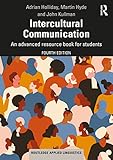Intercultural communication : an advanced resource book for students / Adrian Holliday, John Kullman, and Martin Hyde.
Material type: TextSeries: Routledge applied linguisticsPublisher: Abingdon, Oxon ; New York, NY : Routledge, 2021Edition: 4th editionDescription: xxii, 322 pages: illustrations; 25 cmContent type:
TextSeries: Routledge applied linguisticsPublisher: Abingdon, Oxon ; New York, NY : Routledge, 2021Edition: 4th editionDescription: xxii, 322 pages: illustrations; 25 cmContent type: - text
- unmediated
- volume
- 9780367482466
- 302.23 23
| Item type | Current library | Call number | Status | Barcode | |
|---|---|---|---|---|---|
| Books | PSAU OLM Circulation/Reserved | C 302.23 H739 2021 (Browse shelf(Opens below)) | Available | PSAU42411 |
Browsing PSAU OLM shelves, Shelving location: Circulation/Reserved Close shelf browser (Hides shelf browser)
Includes bibliographical references and index.
Series editors’ preface — ix ; Acknowledgements — xi ; How to use this book — xiii ; SECTION A: Introduction – Defining concepts — p. 1 ; Theme 1: Identity — p. 7 ; Unit A1.1 People like me — p. 7 ; Unit A1.2 Artefacts of culture — p. 11 ; Unit A1.3 Identity card — p. 18 ; Theme 2: Othering — p. 23 ; Unit A2.1 Communication is about not presuming — p. 23 ; Unit A2.2 Stamping identity on new language — p. 27 ; Unit A2.3 Power and discourse — p. 32 ; Theme 3: Representation — p. 38 ; Unit A3.1 Cultural refugee — p. 38 ; Unit A3.2 Complex images — p. 44 ; Unit A3.3 The paradoxes of institutional life — p. 50 ; Unit A3.4 Disciplines for intercultural communication — p. 55 ; SECTION B: Extension — p. 59 ; Introduction to Section B — p. 61 ; Unit B0.1 Current and previous approaches to the study of intercultural communication — p. 61 ; Unit B0.2 Essentialist and non‑essentialist approaches to ‘culture’ — p. 71 ; Theme 1: Identity (Section B) — p. 80 ; Unit B1.1 Questions of identity — p. 80 ; Unit B1.2 Discourse and identity — p. 87 ; Unit B1.3 Cosmopolitanism and identity — p. 97 ; Unit B1.4 Discourse, identity and intercultural communication — p. 104 ; Unit B1.5 Identity and language learning — p. 113 ; Theme 2: Othering (Section B) — starts p. 123 (page range not specified) ; [and so on through Section C…]
"Intercultural Communication provides a critical introduction to the dynamic arenas of communication across different cultural and social strata. Throughout this book, topics are revisited, extended, interwoven and deconstructed, with the reader's understanding strengthened by tasks and follow-up questions. The updated fourth edition of this popular textbook has been updated to feature: new readings by Kwame Antony Appiah, Yoshitaka Miike, Edward Ademolu and Siobhan Warrington, Helena Liu, Michael Zirulnik and Mark Orbe, which reflect the most recent developments in the field; refreshed and expanded examples and tasks including new material on an Asia-centric approach to intercultural communication, selfies as a global discourse, the impact on intercultural communication of English as a lingua franca in multinational organisations, and representations of Africa in charity media campaigns; extended discussions of topics including intercultural training, voluntourism, challenging essentialism in business contexts and intersectional approaches to identity; revised further reading suggestions. Written by experienced teachers and researchers in the field, Intercultural Communication, Fourth edition provides an essential textbook for advanced students studying this topic"-- Provided by publisher.
There are no comments on this title.







